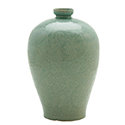|
|
| Show All 56 Results (Text Only) |
|
| Hokusai: Mad About Painting |
|
|
Animated examination of works by the Japanese artist Katsushika Hokusai (1760-1849). This excellent interactive website features an introduction to Hokusai's life, plus an examination of his work, organized into the following categories: COLOR (Hokusai's innovative use of color); BRUSH & BLOCK (the range of Hokusai's creativity, and comparisons of painting and printing techniques); COMPOSITION; and SUBJECT. Uses Flash.
Go to Museum Resource: https://archive.asia.si.edu/exhibitions/online/hokusai/launch.htm | |
|
|
| How to “Read” a Chinese Scroll: More than Just "Right to Left" [PDF] |
|
|
For hundreds of years Chinese painting took three major formats: hand scrolls, hanging scrolls, and album leaves. Important hand scrolls are stored in special boxes and are carefully unrolled and rerolled for viewing a portion at a time by only a few people. Looking at the poetry, painting, and calligraphy on a scroll is like reading a chapter in a book. A Chinese hand scroll is “read” from right to left, the same way classical Chinese writing is read.
Go to Museum Resource: https://www.freersackler.si.edu/wp-content/uploads/2017/07/chinese-scroll-lesso... | |
|
|
| Illusion, Allegories, and Artwork – Monkeys Grasp for the Moon |
|
|
Students will describe the visual qualities and content of works of art as well as the meanings communicated and feelings evoked by works of art. They will compare and contrast different forms, techniques, and meanings in artwork. Additionally, they will analyze the concept of allegory in storytelling and art as they recount stories from diverse cultures and determine the central message, lesson, or moral using key details in the text.
Go to Museum Resource: https://asia.si.edu/learn/for-educators/teaching-china-with-the-smithsonian/les... | |
|
|
| India: Shiva Nataraja (Lord of the Dance) |
|
|
"Nataraja is one of the most important, visually thrilling forms of the Hindu god Shiva... Ta-dum, ta-dum, ta-dum..." beats the drum in Nataraja's hand, as he shakes it, giving rhythm to his dancing feet and sound to his image. Shiva, the auspicious one, is manifest here as the Lord of the Dance, a form he has taken not to entertain but perform cosmic work. Shiva Nataraja is crushing ignorance, presented by the sculptor as a demon under his feet who looks up benevolently at the god, even as his own ruin is in progress..."
Go to Museum Resource: https://asia.si.edu/learn/india-shiva-nataraja-lord-of-the-dance/ | |
|
|
| Iraq and China: Ceramics, Trade, and Innovation |
|
|
"Influenced by sea trade with China, Iraqi pottery was transformed in the 9th century. These innovations, in turn, inspired ceramic arts across the region." With two topics related to technique ("Blue & White" and "Luster") and one related to trade ("Spread of Innovation"); the latter discusses the dissemination of techniques to Iran, Turkey, Egypt, Italy, and England. Uses Flash.
Go to Museum Resource: https://archive.asia.si.edu/exhibitions/online/iraqChina/default.htm | |
|
|
| Isamu Noguchi and Modern Japanese Ceramics Interactive |
|
|
Two interactives follow Noguchi's three journeys to Japan and introduce the Japanese ceramic artists with whom he interacted. Noguchi's international acclaim admitted him to diverse spheres of the art world in postwar Japan. The Japanese ceramic artists with whom Noguchi associated were also pursuing profound questions of personal and artistic identity in the aftermath of war, although they chose varying paths to do so. Uses Flash.
Go to Museum Resource: https://archive.asia.si.edu/exhibitions/online/noguchi/default.htm | |
|
|
| A Journey to Xiangtangshan |
|
|
Carved into the mountains of northern China, the Buddhist cave temples of Xiangtangshan ("Shahng-tahng-shahn") were the crowning cultural achievement of the Northern Qi ("Chee") dynasty (550-77). The name Xiangtangshan translates to "Mountain of Echoing Halls." It refers to two groups of caves: northern Xiangtangshan and southern Xiangtangshan, located about nine miles apart in Hebei province. Commissioned by devout Buddhist emperors and courtiers, the manmade caves represent the power and prestige of the throne and an eternal appeal for divine protection. They also reflect a long tradition, begun in India, of situating holy places within the earth's mantle.
Go to Museum Resource: https://archive.asia.si.edu/explore/china/xiangtangshan/ | |
|
|
| Korean Art: Overview |
|
|
The simple forms, spare decoration, and monochrome glazes of the Joseon period (1392–1910) Korean tea bowls used in Japan first attracted Charles Lang Freer to Korean ceramics. He expanded his collection to include celadon ceramics from the Goryeo dynasty (918–1392), which had once adorned palaces, Buddhist temples, and private residences of the aristocracy. Explore their past exhibits on Korean art.
Go to Museum Resource: https://asia.si.edu/exhibitions/korean-art/ | |
|
|
|
| Show All 56 Results (Text Only) |








